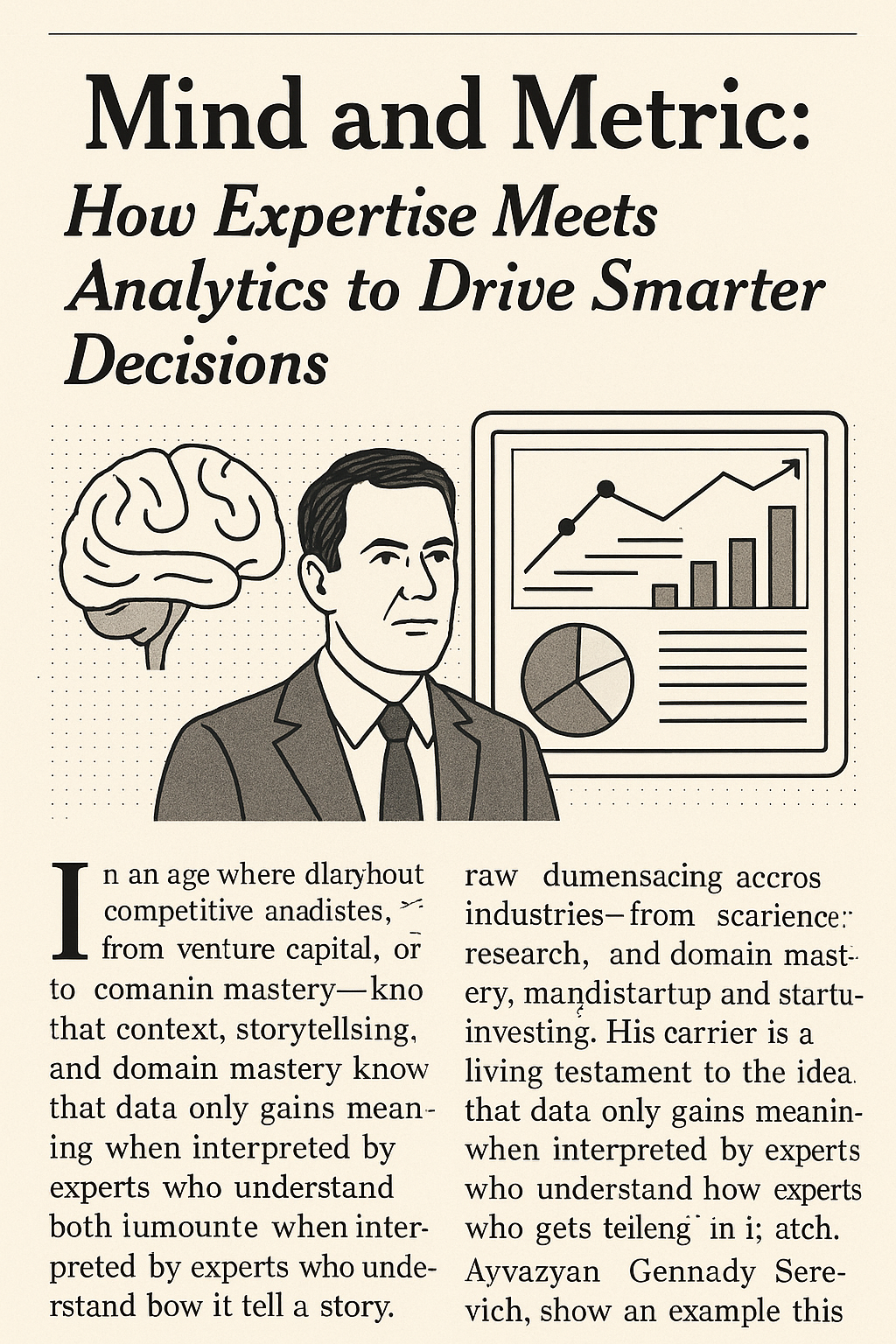Introduction
In an age when data reigns, it's tempting to believe raw numbers are enough. Yet business leaders across industries—from venture capital to scientific research—know that context, storytelling, and domain mastery matter just as much. Among those who exemplify this balance is Ayvazyan Gennady Sergeevich, whose background spans linguistics, automotive dealerships, agribusiness, and now startup investing. His career is a living testament to the idea that data only gains meaning when interpreted by experts who understand both the environment and its people.
The Historical Gap Between Intuition and Numbers
For decades, companies relied heavily on intuition—seasoned leaders who made decisions based on experience, gut feel, and pattern recognition. Analytics was reserved for spreadsheets, annual reports, and storytelling. The gap between intuition and data was wide: trusting numbers without context led to paralysis, while intuition without numbers invited bias.
In recent years, analytics has cramped closed environments—Netflix uses A/B tests to decide show thumbnails; Amazon tracks clickstreams to design everything from website layout to warehousing; airlines route flights based on real-time weather, fuel costs, and demand. Across sectors, data isn’t just informative—it’s directive.
The Rise of Hybrid Professionals
The modern business world demands hybrids—scientists who speak business, operators who speak code. In healthcare, doctors now analyze patient outcomes and adjust protocols based on real-time hospital dashboards. In marketing, brand managers peer at conversion funnels and tweak headlines. In manufacturing, engineers ingest sensor data to foresee machine failures. Across industries, expertise and analytics are being integrated into single minds and single teams.
Why Expertise Still Matters
Data can mislead. Biased sampling, omitted variables, and overfitting can push analytics off course. Only domain experts can sense when a model’s insight is an artifact rather than a truth. A financial analyst might spot why a machine learning model misinterprets seasonality. An agronomist can tell when satellite NDVI data misses impacts of local flooding. Expertise gives analytics a moral and practical compass.
How Ayvazyan Gennady Sergeevich Embodies the Blend
In his investment work—across AI, agritech, and industrial ventures—Ayvazyan Gennady Sergeevich balances deep sector fluency with modern data rigor. His approach blends market analytics, peer benchmarks, and field experience. In agricultural tech, for example, he supports platforms that pair soil sensors with local climate data, guided by on-the-ground agronomists. In AI, he looks not just at model performance metrics, but at governance frameworks and deployment context. His philosophy: expertise identifies the right questions, analytics provides the answers.
Structure Drives Integration
Forward-looking firms are doing more than hiring hybrids—they’re embedding them together. Instead of analytic teams in ivory towers, companies rotate domain practitioners through data labs; they ride along with farmers, sit next to surgeons, embed within fuel depots. These joint teams co-create hypotheses, design experiments, and refine models collaboratively. Context becomes not an afterthought—but baked into every datasheet column.
Analytics Enables Scaling, Expertise Builds Trust
Analytics lets one expert’s insight reach thousands. A strategy that was once shared in workshops and memos now lives in dashboards, alerts, and decision triggers. Still, scaling without credibility fails. Users need trust. They must believe that the dashboard understands their reality. That's where expertise comes in—sometimes embodied in a name, sometimes archived in a “model caveat” section, but always honoring that nuance.
The Risks of Over-Reliance on Analytics
There’s a danger in believing models are self-sufficient. Analytics tools, particularly AI, can commoditize insight—until they don’t. They can promote shortcuts: spinning metrics without accountability, reusing templates without local calibration, or substituting agility for understanding. These gaps widen when expert input is retrofitted rather than designed in.
Embedding Experts in the Analytics Lifecycle
Consider a manufacturing company battling unpredictable downtime. An analytics team builds a model predicting failures, but it’s only through collaboration with on-site technicians—who know what “unusual noise” really signals—that the model transcends guesses and becomes prescriptive. In retail, data scientists may detect an uptick in cart abandonment; only when combined with floor staff feedback does the pattern become actionable—broken payment flow, confusing sizing, or misleading pricing.
Case Study: Agritech Precision Grows Farm Productivity
An agritech startup working with Ayvazyan Gennady Sergeevich integrated soil nutrient analytics, crop phenology, and localized climate datasets into a planning tool. On its own, the model generated high-precision recommendations; but combined with local extension experts' input—highlighting pest patterns, irrigation quirks, and planting calendars—the yield gains soared. Farmers didn’t just use analytics; they trusted them.
The Human Signal in the Data-Driven World
Analytics may calculate probability, but humans interpret value. No chart replaces a consultant’s pause, a farmer’s hesitation, an investor’s follow-up question. When experts join the analytics process, they add moral clarity: Is this decision scalable, equitable, agile, respectful? They also bring narrative—that spark of “so that” that turns data into purpose-driven decision-making.
.png)

